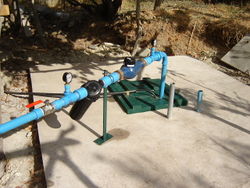Difference between revisions of "SPIS Toolbox - Monitoring System"
***** (***** | *****) |
***** (***** | *****) |
||
| Line 42: | Line 42: | ||
More sophisticated (and expensive) monitoring devices may include automatic data logging. The data logger continuously records and stores all system parameters over a longer period of time. Special evaluation software allows for quick data analysis on site. In remote areas not connected to the public grid, data loggers are usually solar-powered and may even include modern communication devices (GSM) with the option of checking system performance via smart phones (also refer to the '''[[SPIS Maintain|MAINTAIN]]''' module). | More sophisticated (and expensive) monitoring devices may include automatic data logging. The data logger continuously records and stores all system parameters over a longer period of time. Special evaluation software allows for quick data analysis on site. In remote areas not connected to the public grid, data loggers are usually solar-powered and may even include modern communication devices (GSM) with the option of checking system performance via smart phones (also refer to the '''[[SPIS Maintain|MAINTAIN]]''' module). | ||
{{SPIS Reference}} | {{SPIS Reference}} | ||
| + | {| cellpadding="1" | ||
| + | |- | ||
| + | | {{Back to SPIS Toolbox 2}} | ||
| + | | | ||
| + | | {{Back to Get Informed}} | ||
| + | | | ||
| + | | style="width: 150px; background-color: rgb(222, 226, 192);" | <span style="color:#000000;"><span style="font-size: 90%">'''[[SPIS_Toolbox_-_Reservoir|►Go to the Next Chapter]]</span></span> | ||
| + | |} | ||
Revision as of 14:54, 28 March 2018

| ►Back to the Start Page | ►Back to the Module Page | ►Go to the Next Chapter |
6. Monitoring System
Operated by the producer on-site or on-line, the monitoring system allows readings of pressure, water flow and water level and helps to assess the performance of the system.
It is used
- to observe and track the system’s operation and performance;
- to control pumping quantities to the irrigation system;
- to provide system data for the acceptance test after installation; and
- to avoid negative environmental impacts (e.g. ground water depletion).
Ultimately, monitoring is important to ensure that the system operates within sustainable limits for long-term productivity of the farm.
Some solar pump manufacturers have included monitoring systems in their product portfolios. Each SPIS should have a basic monitoring system comprising pressure gauges, a flow meter and a water level dipper. The water level dipper is a simple tool to check the water level in a well. Once the metal electrode reaches the water table, a light will flash and the exact value can be read from the dipper tape. Checking the water level several times over the course of the day gives an indication on the dynamic behavior of the well. The dynamic water level is an important parameter to determine the total pumping head (refer to DESIGN module).
Especially in cases where the water is pumped directly to the irrigation system without passing through an elevated reservoir, it is important to monitor water flow and pressure in the irrigation system as the amount of water delivered to plants may vary widely across the field. The picture above displays a monitoring system, which is composed of a water flow meter and pressure gauges on each side of the filter, which allow the monitoring of the pressure loss through the filter.
A more sophisticated monitoring system would include sensors to measure
- solar irradiance (e.g. on horizontal and inclined surface);
- rainfall, relative humidity and wind speed; and
- the total pumping head.
In addition, the monitoring system can be expanded with sensors in the reservoir and in the irrigation system itself.
More sophisticated (and expensive) monitoring devices may include automatic data logging. The data logger continuously records and stores all system parameters over a longer period of time. Special evaluation software allows for quick data analysis on site. In remote areas not connected to the public grid, data loggers are usually solar-powered and may even include modern communication devices (GSM) with the option of checking system performance via smart phones (also refer to the MAINTAIN module).
| ►Back to the Start Page | ►Back to the Module Page | ►Go to the Next Chapter |




















